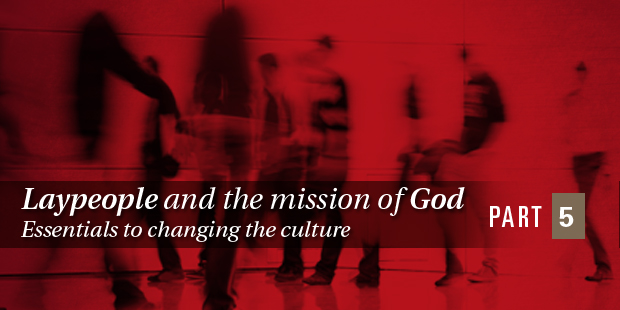
Laypeople and the Mission of God, Part 5
Where do you start engaging laypeople in your church on a higher level? Today I continue my series on laypeople and the mission of God by giving action steps to implement in your church. The goal is to get people of the sidelines moving them from fan to player.
1. Communication is essential to change the culture of your church. You want to see those thinking like fans start to think like players. Weird word picture, don’t you think? What fan would you want to play for your favorite team? But God has always chosen the willing over the gifted.
You can’t assume that people understand their gifts, roles, or the expectations God has for them. Actually, based on the passivity in most churches, I might need to say that you should assume they do not understand the gifts, roles, or the expectations God has for them. My guess, some don’t and some do– but most are either unaware or unwilling. Most of the time, it is some of both.
My exhortation is to take the time to communicate vision, expectations, and the implementation of a plan to change the culture. Years ago, I led a small, rural church to engage more fully in ministry and mission. Our attendance was about 100 people on a weekend. Of the 100 about 20 were involved in any meaningful ministry and mission. Our first step was to ask the 20 to become partners in fixing the problem. We told them “we know you’re already serving, but we want to ask you to help us. Would you to take courses on how to find your gifts so that you can tell everyone how helpful they are and then recruit others to do the same?” They said yes, and we started that process.
We started getting these people as our advocates because they wanted to advocate– they were already tired and overworked, but we wanted them on our side. Our goal was to double our co-laborer team. So, we asked them to find one person in the first round so we could get 40 people that would go through this process. And they did.
We slowly built. I don’t believe that you’re going to get to 100% in an old, established church unless you have powers to kick people out or uncanny powers of persuasion. A reasonable goal is 50% to have some sort of ministry role in the church. A transformational church has around 70%. But 50% is reachable– and for most churches, it is much lower. So, communicate the goal, the number of people needed to reach the goal, and talk it to death! Preach, sing, announce, e-news, and tweet it. Communicate the “Why?” in big ways. Comeback leaders take the time to communicate vision, expectations, and implementation of the plan.
2. Growth demands empowered leaders– and unafraid pastors. Too many pastors are afraid of the people. We think we can control them by acting like a parent and trying to make a perfect, care-free ministry world. But when we act that way they usually control us, and we still fall short of the outcomes we crave. And even worse we become frustrated, burned-out leaders.
A lack of empowered leaders consistently hinders the health of a church. Those of us who write on growing churches would say that growth barriers are leadership barriers. These are real barriers and the answer is more, better, and empowered leaders.
For example, many churches get stuck at the 35 attendance barrier. You will find is that that 35 barrier is most likely going to be broken when we go from one key leader (probably the pastor) doing almost everything to a shared leadership plan with people serving in multiple areas. For example, in a small, growing rural church, that might mean somebody is in charge of children and students, somebody is in charge of small groups or Sunday School, and maybe someone is in charge of outreach. However, to see that 35 attendance church thrive and engage in transformation, there would be more people involved, empowered, engaged, and serving.
No matter the roles, as a church crosses a barrier it happens because leadership and roles expand. Churches grow as leadership expands. It is not the only reason, but without it, leadership becomes the lid– the limiting factor.
So, when we get to the 75 barrier, what you find is you often need these leaders to become “leaders of leaders.” As an example, let’s go back to the traditional rural church. At the 35 barrier, your Sunday School coordinator has 3 teachers. So at the 75 barrier you need those three leaders and seven other workers to be growing– and much more to be thriving.
Here are two graphics that might be of help. I am still tweaking them, so feel free to give your thoughts in the comments. Here they are. First, what it looks like to have a growing church. Second, what a transformational church looks like:
For many, the traditional church example will trip them up. They think the answer is to abandon these churches and their structures and, for example, go to house churches, or contemporary ones, for that matter. I get their concern, but my concern is for all kinds of churches. My church is a non-traditional church with small groups, and these principles still apply (and, as a new church, we are not yet where we want to be).
Obviously, this means you have to do more than bemoan the lack of lay involvement– you need a leadership strategy to fix it. Churches must have a plan to empower lay people through a leadership development strategy. If you are a pastor, that will change how you do ministry– spending more time developing leaders so that a broad engagement of lay leaders is a church-wide function.
For example, your schedule has to reflect a desire to engage all God’s people in ministry and mission. So you need weekly or monthly meetings with leaders of leaders, who then meet with other leaders, who then develop new leaders.
Remember, that means overcoming fear. Why? Because it is a scary thing to empower all God’s people, not just as workers, but as leaders– and even leaders of leaders. Will some of them fail? Absolutely.
However, you cannot fix the lack of lay involvement without giving permission and empowerment for people to be leaders. You cannot fix the lack of lay involvement without systems to empower people. You cannot fix the lack of lay involvement without giving leaders empowerment to make more leaders.
Read Part 6 here.
Begin the series here.
Read more from Ed here.

Tags: Communication, Ed Stetzer, Empowerment, Serve













